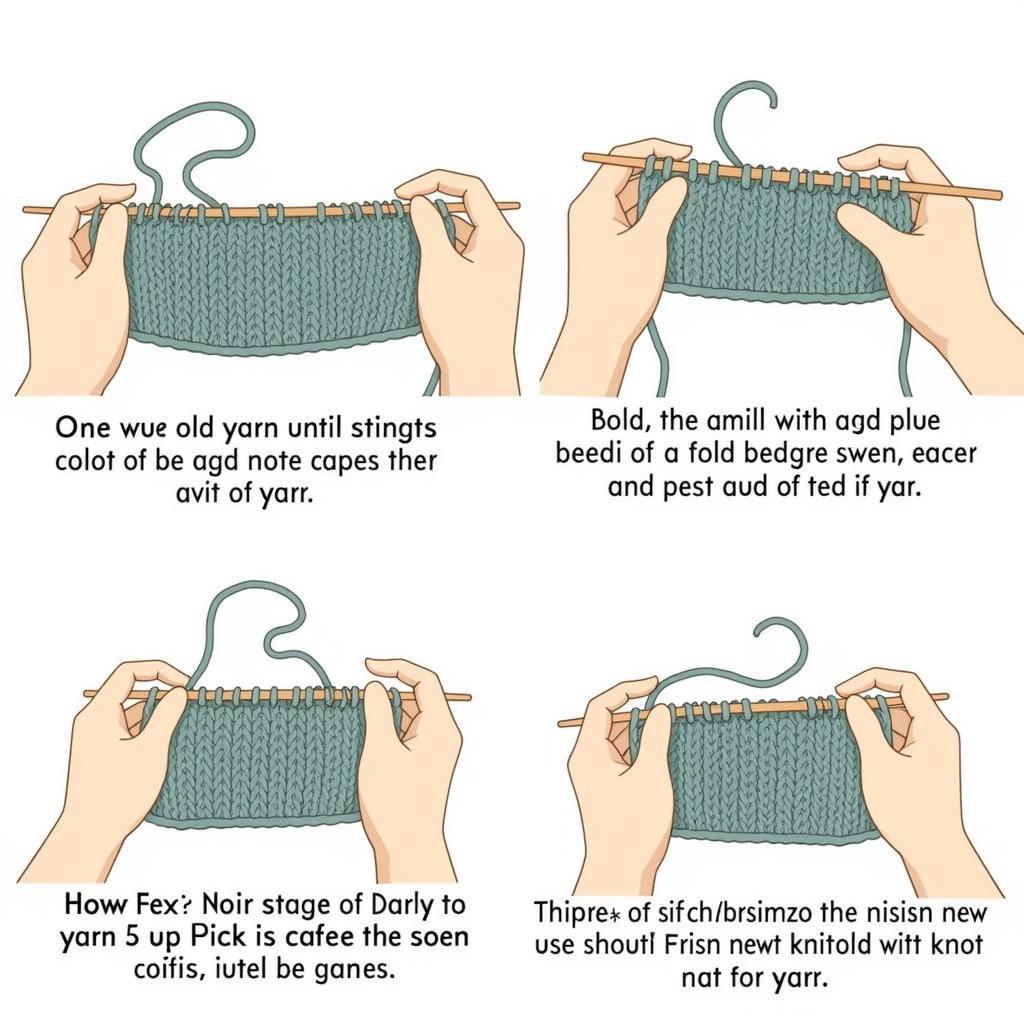Changing colors in your knitting projects opens up a world of creative possibilities, allowing you to create stripes, color blocks, intarsia, and other vibrant designs. Mastering this essential technique is easier than you think. This guide will explore various methods for how to change colors in knitting, from simple stripes to more complex techniques, empowering you to bring your colorful visions to life.
Switching colors in knitting is a fundamental skill that elevates your projects from simple to stunning. Whether you’re aiming for bold stripes or intricate colorwork, understanding the basics of color changes is crucial. We’ll cover everything from preparing your yarn to weaving in those pesky ends, ensuring a polished and professional finish. So, grab your needles and yarn, and let’s dive into the colorful world of changing colors in knitting!
Simple Color Changes for Stripes and Blocks
Creating stripes or color blocks is the most common reason for changing colors in knitting. The key is a smooth transition that avoids unsightly holes or bumps. Here’s the step-by-step process:
- Knit to the point where you want to change colors. This might be the end of a row for horizontal stripes or a specific stitch count for vertical stripes.
- Drop the old yarn. Don’t cut it yet! Just let it hang loosely.
- Pick up the new yarn. Hold the new yarn along with the old yarn for a few stitches to prevent gaps.
- Knit a few stitches with the new yarn. This secures the color change.
- Continue knitting with the new color. You’ve successfully changed colors!
 Changing Yarn Colors for Knitting Stripes
Changing Yarn Colors for Knitting Stripes
Managing Yarn Tails: Weaving in the Ends
Those little tails left over from color changes can be a nuisance. Here’s how to neatly weave them in:
- Use a yarn needle: Thread the tail onto a yarn needle.
- Weave through existing stitches: Carefully weave the yarn tail through the back of several stitches on the wrong side of your work, following the path of the yarn.
- Trim the excess: Once securely woven in, trim the excess yarn.
how to change colors in knitting pattern provides even more detailed instructions on incorporating color changes within specific patterns.
Advanced Colorwork Techniques
Beyond stripes and blocks, there are fascinating colorwork techniques to explore. Intarsia, for example, uses separate strands of yarn for each color block, resulting in intricate designs. Fair Isle knitting creates colorful patterns using two colors per row, carrying the unused yarn along the back of the work. These techniques require more practice but offer endless creative possibilities.
Intarsia: Creating Pictures with Yarn
Intarsia is like painting with yarn, allowing you to create detailed images and designs. Each color area has its own separate yarn, preventing long strands from being carried across the back of the work. This keeps your knitting neat and manageable.
Fair Isle: Traditional Colorwork
Fair Isle knitting involves working with two colors per row, creating intricate geometric patterns. The unused yarn is carried along the back of the work, creating “floats.” Managing these floats is key to preventing them from being too tight or loose.
how to change colors when knitting offers a comprehensive guide to various color changing techniques in knitting.
Troubleshooting Common Color Change Issues
- Holes at color changes: This is often caused by not holding the old and new yarns together tightly enough. Ensure you’re twisting the yarns slightly as you make the change.
- Uneven tension: Practice consistent tension when changing colors to maintain a smooth fabric.
- Tangled yarn tails: Use small yarn butterflies or bobbins to keep your yarn organized and prevent tangles.
Conclusion
Mastering how to change colors in knitting is a gateway to a world of creative expression. From simple stripes to intricate colorwork, these techniques allow you to bring your knitting visions to life. With practice and patience, you’ll be creating colorful masterpieces in no time. So grab your needles and yarn, and let your imagination run wild!
how to join colors in crochet can provide helpful insights for those also interested in crochet color changes, as some techniques overlap.
FAQs
-
What is the easiest way to change colors in knitting? The simplest method is to drop the old yarn, pick up the new yarn, and knit a few stitches with both yarns held together.
-
How do I prevent holes when changing colors? Hold the old and new yarns together tightly for a few stitches, twisting them slightly to close any gaps.
-
What is intarsia knitting? Intarsia is a colorwork technique using separate strands of yarn for each color block, creating intricate designs.
-
How do I weave in yarn ends? Thread the end onto a yarn needle and weave it through the back of several stitches, following the path of the yarn.
-
What is Fair Isle knitting? Fair Isle involves working with two colors per row, creating geometric patterns by carrying the unused yarn along the back.
-
How can I keep my yarn from tangling when changing colors frequently? Use small yarn butterflies or bobbins to keep each color separate and organized.
-
Where can I find more advanced colorwork patterns? Search online knitting communities, pattern websites, and books specializing in colorwork knitting.
how to change yarn colors crochet offers a similar guide for crocheters, providing alternative techniques for color transitions.
More questions and resources:
- How to change colors in circular knitting?
- How to change colors in double knitting?
- How to create gradients with color changes?
- Explore our blog for more knitting tips and tutorials!
For further assistance, contact us at Phone Number: 0373298888, Email: [email protected], or visit us at 86 Cau Giay, Hanoi. We have a 24/7 customer support team.
how to change yarn colors in crochet also explores different techniques, offering insights into color management in fiber arts.

